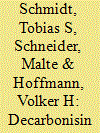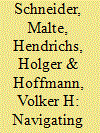|
|
|
Sort Order |
|
|
|
Items / Page
|
|
|
|
|
|
|
| Srl | Item |
| 1 |
ID:
112274


|
|
|
|
|
| Publication |
2012.
|
| Summary/Abstract |
In the power sector, technological change is a key lever to address the decarbonisation needed to avoid dangerous climate change. Policy makers aim to accelerate and redirect technological change by targeting relevant firms via climate policy, e.g., the European Union Emissions Trading System (EU ETS), and climate-relevant technology policies, e.g., feed-in tariffs. Changes in firm's behaviour, i.e., their research and development (R&D) as well as diffusion activities, are at the heart of technological change. However, firms are heterogeneous actors with varying attributes which perceive policy differently. Hence, they can be expected to react very heterogeneously to these new policies. Based on an original dataset of 201 firms, we perform a cluster analysis grouping firms along their R&D and diffusion activity changes. We then compare these clusters with regards to the characteristics of the contained firms. Our analysis results in seven clusters showing very diverse contributions to low-carbon technological change, suggesting potential for policy to become more effective. A comparison of the firms' characteristics allows us to derive indicative recommendations on how to adjust the policy mix in order to induce contributions from most firms in the power sector.
|
|
|
|
|
|
|
|
|
|
|
|
|
|
|
|
| 2 |
ID:
093499


|
|
|
|
|
| Publication |
2010.
|
| Summary/Abstract |
From a slow start, the clean development mechanism (CDM) market has recently experienced enormous growth. However, the CDM market has been increasingly criticised, resulting in a lively debate about how to reform, complement, or replace it. In order to increase transparency and assist policy-makers in better understanding the current market, we depart from the traditional project-level perspective on CDM and analyse commercial activities by utilising data from UNEP Risoe's CDM Bazaar. To this end, we first establish a seven-step value chain by conducting a factor analysis on the commercial activities indicated in the Bazaar and, second, identify nine prevalent business models with a cluster analysis of all 495 participating organisations. Based on these analyses, we discuss potential impacts on the value chain of different policy scenarios that rely on carbon credits as incentive. We find that the importance of specific regulatory CDM know-how and general business activities such as finance varies strongly with the different policy scenarios. Our analysis serves to sensitise policy-makers and business about implications of different regulatory designs.
|
|
|
|
|
|
|
|
|
|
|
|
|
|
|
|
| 3 |
ID:
109684


|
|
|
|
|
| Publication |
2011.
|
| Summary/Abstract |
Solar power technologies will have to become a major pillar in the world's future energy system to combat climate change and resource depletion. However, it is unclear which solar technology is and will prove most viable. Therefore, a comprehensive comparative assessment of solar technologies along the key quantitative and qualitative competitiveness criteria is needed. Based on a literature review and detailed techno-economic modeling for 2010 and 2020 in five locations, we provide such an assessment for the three currently leading large-scale solar technologies. We show that today these technologies cannot yet compete with conventional forms of power generation but approach competitiveness around 2020 in favorable locations. Furthermore, from a global perspective we find that none of the solar technologies emerges as a clear winner and that cost of storing energy differs by technology and can change the order of competitiveness in some instances. Importantly, the competitiveness of the different technologies varies considerably across locations due to differences in, e.g., solar resource and discount rates. Based on this analysis, we discuss policy implications with regard to fostering the diffusion of solar technologies while increasing the efficiency of policy support through an adequate geographical allocation of solar technologies.
|
|
|
|
|
|
|
|
|
|
|
|
|
|
|
|
|
|
|
|
|